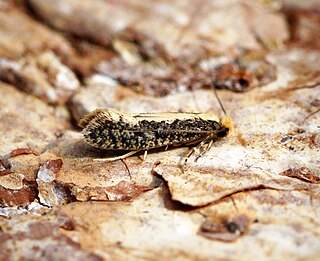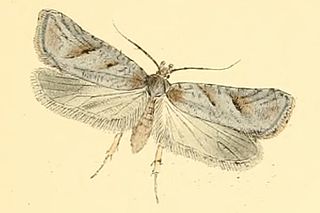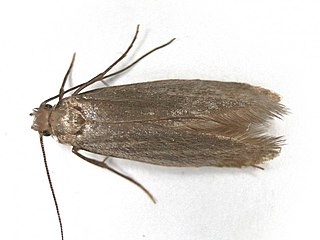Related Research Articles

Tinea semifulvella is a species of tineoid moth. It belongs to the fungus moth family (Tineidae), and therein to the nominate subfamily Tineinae. It is widespread and common in much of the western Palearctic, but seems to be absent from Portugal and the Balkans as well as the outlying islands. The nocturnal adults are on the wing around May to September, depending on the location, and are easily attracted to light sources.

Tinea pellionella, the case-bearing clothes moth, is a species of tineoid moth in the family Tineidae, the fungus moths. This species has a cosmopolitan distribution, occurring nearly worldwide.
Ephedroxena is a genus of moths belonging to the family Tineidae. It contains only one species, Ephedroxena incisoria, which is found in Guyana.

Homodoxus is a genus of moths belonging to the family Tineidae. It contains only one species, Homodoxus aristula, which is found in Mexico and Guatemala.

Monopis crocicapitella, the pale-backed clothes moth, is a moth of the family Tineidae described by James Brackenridge Clemens in 1859. It has a nearly cosmopolitan distribution. It was first described from the eastern United States. It is particularly destructive of fabric and clothes.

Exaeretia allisella is a moth of the family Depressariidae. It is found in most of northern and central Europe, Siberia, the Russian Far East, Mongolia and northern and central China.
Petasactis is a genus of moths belonging to the family Tineidae. It contains only one species, Petasactis technica, which is endemic to New Zealand. This species has not been collected since prior to 1888. It is classified as "Data Deficient" by the Department of Conservation.

Infurcitinea argentimaculella, the silver-barred clothes moth, is a moth of the family Tineidae. It was described by Stainton in 1849. It is found in most of Europe, except Ireland, Portugal, Latvia, Lithuania and the Balkan Peninsula.

Erechthias lychnopa is a species of moth in the family Tineidae. This species is endemic to New Zealand and has only been collected in a karaka grove at Sinclair Head in Wellington in November. It has yet to be collected again. It has been hypothesised that the larvae inhabit dead wood. It is classified as "Data Deficient" by the Department of Conservation.

Trachycentra calamias is a moth of the family Tineidae described by Edward Meyrick in 1886. It is found on the Cook Islands, Fiji, French Polynesia and Tonga.

Trachycentra chlorogramma is a moth of the family Tineidae. It is found on the Cook Islands, Fiji, Papua New Guinea, the Solomon Islands and Tonga.
Tiquadra cultrifera is a moth of the family Tineidae. It is known from Benin, Democratic Republic of the Congo, Ghana and Nigeria.
Opogona percnodes is a moth of the family Tineidae. It is found in India and Sri Lanka.
Amphixystis fragosa is a moth of the family Tineidae. This species is known from Mauritius and Réunion. On Réunion, adults are on wing year-round.
Tiquadra drapetica is a moth of the family Tineidae. It is known from Brazil and Peru.
Niditinea praeumbrata is a moth of the family Tineidae. It is known from Cuba, Bermuda, Costa Rica and Guyana.

Amphixystis cymataula is a moth of the family Tineidae. It was described by Edward Meyrick in 1909 and is found in Zimbabwe.

Tinea columbariella is a moth belonging to the family Tineidae. The species was first described by Wocke in 1877.
Tinea flavescentella is a species of moth belonging to the family Tineidae. It is native to Western Europe. The wingspan is 8–17 mm. Head with pale yellow hair tuts. Antennae just over half the front wing length. The forewings are greyish yellow with two or three grey-brown spots and a faint hyaline spot at the base. Hindwings grey. Certain identification requires examination of the genitalia. Flies at night in August. It is found indoors where fur and wool goods are kept.
Tinea dubiella is a species of moth belonging to the family Tineidae.